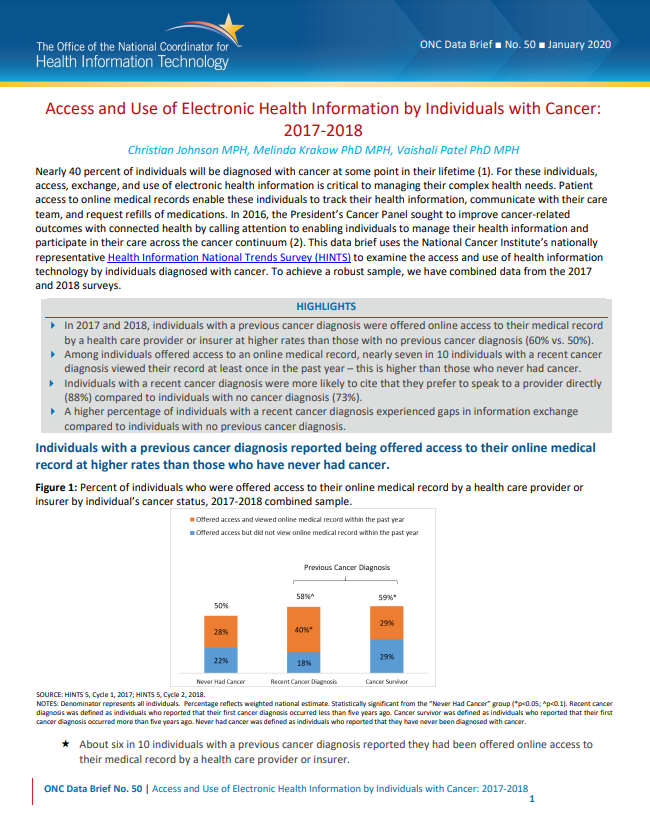Nearly 40 percent of individuals will be diagnosed with cancer at some point in their lifetime. For these individuals, access, exchange, and use of electronic health information is critical to managing their complex health needs. Patient access to online medical records enable these individuals to track their health information, communicate with their care team, and request refills of medications. In 2016, the President's Cancer Panel sought to improve cancer-related outcomes with connected health by calling attention to enabling individuals to manage their health information and participate in their care across the cancer continuum. This data brief uses the National Cancer Institute's nationally representative Health Information National Trends Survey (HINTS) to examine the access and use of health information technology by individuals diagnosed with cancer. To achieve a robust sample, we have combined data from the 2017 and 2018 surveys.
HIGHLIGHTS
- In 2017 and 2018, individuals with a previous cancer diagnosis were offered online access to their medical record by a health care provider or insurer at higher rates than those with no previous cancer diagnosis (60% vs. 50%).
- Among individuals offered access to an online medical record, nearly seven in 10 individuals with a recent cancer diagnosis viewed their record at least once in the past year – this is higher than those who never had cancer.
- Individuals with a recent cancer diagnosis were more likely to cite that they prefer to speak to a provider directly (88%) compared to individuals with no cancer diagnosis (73%).
- A higher percentage of individuals with a recent cancer diagnosis experienced gaps in information exchange compared to individuals with no previous cancer diagnosis.
Individuals with a previous cancer diagnosis reported being offered access to their online medical record at higher rates than those who have never had cancer.
Figure 1: Percent of individuals who were offered access to their online medical record by a health care provider or insurer by individual’s cancer status, 2017-2018 combined sample.
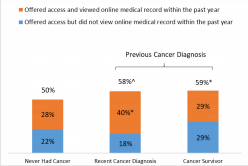
SOURCE: HINTS 5, Cycle 1, 2017; HINTS 5, Cycle 2, 2018
NOTES: Denominator represents all individuals. Percentage reflects weighted national estimate. Statistically significant from the “Never Had Cancer” group (*p<0.05; ^p<0.1). Recent cancer diagnosis was defined as individuals who reported that their first cancer diagnosis occurred less than five years ago. Cancer survivor was defined as individuals who reported that their first cancer diagnosis occurred more than five years ago. Never had cancer was defined as individuals who reported that they have never been diagnosed with cancer.
★ About six in 10 individuals with a previous cancer diagnosis reported they had been offered online access to their medical record by a health care provider or insurer.
Among individuals offered access to an online medical record, nearly seven in 10 individuals with a recent cancer diagnosis viewed their record at least once in the past year.
Figure 2: Frequency of viewing an online medical record within the past year among those who had been offered an online medical record by a health care provider or insurer by cancer status, 2017-2018 combined sample.
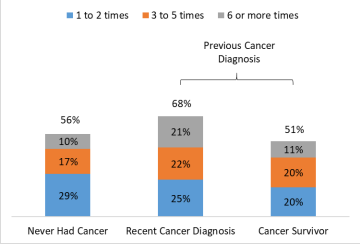
SOURCE: HINTS 5, Cycle 1, 2017; HINTS 5, Cycle 2, 2018.
NOTE: Denominator represents individuals who were offered access to their online medical record. Statistically significant from the “Never Had Cancer” group (*p<0.05).
★ Among individuals offered access to an online medical record, those with a recent cancer diagnosis reported viewing their record at higher rates compared with individuals who never had cancer.
★ Among individuals offered access to an online medical record, those with a recent cancer diagnosis were two times more likely to view their record six or more times in the past year compared to who never had cancer.
★ Cancer survivors viewed their online medical record in the past year at similar rates to those who never had cancer.
Individuals with a previous cancer diagnosis most commonly cited a preference to speak to a health care provider directly as the reason why they did not view their online medical record.
Table 1: Reasons for not accessing online medical record as reported by individuals who did not view their online medical record within the past year by cancer status, 2017-2018 combined sample.
SOURCE: HINTS 5, Cycle 1, 2017; HINTS 5, Cycle 2, 2018.
NOTES: Denominator represents individuals who were offered access but did not view their online medical record within the past year. Statistically significant from the “Never Had Cancer” group (^p<0.1).
★ Among those who did not view their online medical record within the past year, more than half of individuals with a previous cancer diagnosis cited that they did not have a need to use their online medical record.
★ Individuals with a recent cancer diagnosis were more likely to cite that they prefer to speak to a provider directly (88%) compared to individuals with no cancer diagnosis (73%).
★ Among those who did not view their online medical record within the past year, there were no differences by cancer status for not viewing their record due to lack of need to use their online medical record, concerns about privacy and security, or no longer having a record.
The types of information in individuals’ online medical record did not vary by having a previous cancer diagnosis.
Figure 3: : Types of information reported in individuals’ online medical record amongst those who were offered and accessed their record at least once by cancer status, 2017-2018 combined sample.
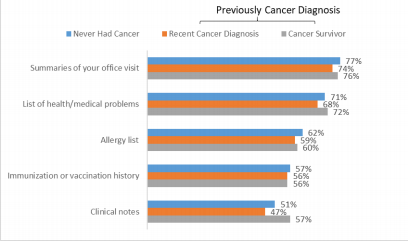
SOURCE: HINTS 5, Cycle 1, 2017; HINTS 5, Cycle 2, 2018.
NOTE: Denominator represents individuals who were offered and viewed their online medical record within the past year
★ A majority of individuals reported that their online medical record included summaries of their office visits and a list of their health/medical problems.
★ Among individuals who viewed their online medical record in the past year, about six in 10 individuals with a previous cancer diagnosis reported that their record included their vaccination history and allergy list.
★ Among individuals who viewed their online medical record in the past year, about half of individuals with a previous cancer diagnosis reported that their online medical record included clinical notes.
Individuals’ use of online medical record did not vary by cancer status.
Table 2: : Reported online medical record functionalities used by individuals who were offered and accessed their record at least once by cancer status, 2017-2018 combine sample.
SOURCE: HINTS 5, Cycle 1, 2017; HINTS 5, Cycle 2, 2018.
NOTE: Denominator represents individuals who were offered access to the online medical record and viewed their online medical records at least once within the last year. Statistically significant from the “Never Had Cancer” group (^p<0.1).
★ About a quarter of individuals with a recent cancer diagnosis viewed their record and transmitted data to an outside party (another healthcare provider, caregiver, or app/service).
★ Among individuals who viewed their online medical record in the past year, more than four in 10 individuals with a previous cancer diagnosis used their online medical record to request medication refills.
★ Few individuals with a previous cancer diagnosis requested corrections of inaccurate information in their online medical record.
★ About half of individuals with a recent cancer diagnosis viewed their record and used secure messaging to communicate with a health care provider.
★ Cancer survivors were less likely use their online medical record to fill out paperwork than those who never had cancer.
Individuals with a previous cancer diagnosis were more likely to be older, insured, have visited a doctor in the past year, and have a chronic condition.
Table 3: :Socio-demographic and health-related characteristics of individuals by cancer status, 2017-2018 combined sample.
SOURCE: HINTS 5, Cycle 1, 2017; HINTS 5, Cycle 2, 2018.
NOTES: Denominator represents all individuals. Percentage reflects weighted national estimate. Statistically significant from the “Never Had Cancer” group (*p<0.05). Chronic condition was defined as having at least one of the following conditions: diabetes, hypertension, chronic heart disease, chronic lung disease, arthritis, or a mental health condition.
★ Nearly all individuals with a previous cancer diagnosis were insured and visited a doctor in the past year
★ There were no differences in household income, education, and geography (rural vs. urban) by cancer status.
★ About three-quarters of individuals with a previous cancer diagnosis also had a chronic health condition.
About three-quarters of individuals with a previous cancer diagnosis reported owning a tablet or smartphone.
Table 4: Percent of individuals who reported having a smartphone, tablet, electronic monitoring device, or health and wellness app, 2017-2018 combined sample.
SOURCE: HINTS 5, Cycle 1, 2017; HINTS 5, Cycle 2, 2018.
NOTE: Denominator represents all individuals. Percentage reflects weighted national estimate. Statistically significant from the “Never Had Cancer” group (*p<0.05; ^p<0.1).
★ Individuals with a previous cancer diagnosis reported owning smartphones at lower rates compared to individuals who have never had cancer.
★ Tablet ownership did not vary by having a previous diagnosis of cancer in 2017 and 2018.
★ Cancer survivors reported lower rates of having a health & wellness app on their tablet or smartphone compared to individuals with no previous cancer diagnosis.
★ About a third of individuals nationwide reported owning an electronic monitoring device.
Nearly four in 10 cancer survivors who used a health & wellness app or other electronic monitoring devices reported sharing information from their device with a health professional.
Table 5: Percent of individuals who reported using their health and wellness app or other electronic monitoring device to help discuss, track, and/or make decisions regarding their health by cancer status, 2017-2018 combined sample.
SOURCE: HINTS 5, Cycle 1, 2017; HINTS 5, Cycle 2, 2018.
Note: Examples of an electronic monitoring device include Fitbit, blood glucose meter, and/or blood pressure monitor. 1Denominator represents the sample of individuals that report having a health and wellness app; 2Denominator represents the sample of individuals that report having a health and wellness app or electronic monitoring device.
★ About two-thirds of individuals with a previous cancer diagnosis used a health & wellness app to track progress on a health related goal (e.g. quit smoking, lose weight, or increase physical activity).
★ About half of individuals with a previous cancer diagnosis used their health & wellness app to discuss their health with a health care provider and to make treatment decisions.
★ Fewer individuals with a recent cancer diagnosis used their health & wellness apps to track progress on a health-related goal compared to individuals who have never had cancer.
Individuals with a recent cancer diagnosis were more likely to experience a gap in information exchange compared to individuals who have never had cancer.
Figure 4: Percent of individuals who reported a gap in information exchange by cancer status, 2017-2018 combined sample.
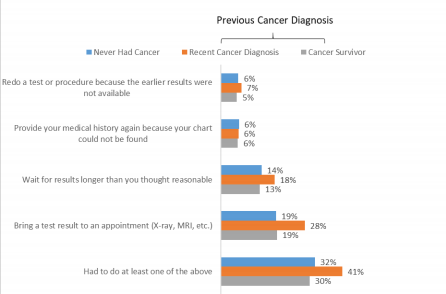
SOURCE: HINTS 5, Cycle 1, 2017; HINTS 5, Cycle 2, 2018
NOTE: Denominator represents individuals who went to a health care provider at least once within the past year (Never had cancer = 81%; Recent Cancer Diagnosis = 97%; Cancer Survivor = 93%). Statistically significant from the “Never Had Cancer” group (*p<0.05; ^p<0.1).
★ Four in 10 individuals with a recent cancer diagnosis experienced a gap in information exchange.
★ More than a quarter of individuals with a recent cancer diagnosis reported having to bring a test result to appointment.
★ Few individuals reported having to redo a test/procedure or provide their medical history again because their health information was not available
Summary
There are almost 17 million cancer survivors in the United States. Today, individuals with a previous cancer diagnosis represent a growing segment of the population (3). Access to online medical records can enable cancer patients and survivors to manage complex and ongoing health information needs (4). Approximately 60 percent of individuals with a previous cancer diagnosis reported being offered access to their online medical record by a healthcare provider or insurer. Among individuals who were offered access, five in 10 cancer survivors and seven in 10 individuals with a recent diagnosis reported viewing their online medical record at least once within the past year (5).
Individuals with a previous cancer diagnosis were offered access to their online medical records at higher rates compared to those who never had cancer. This is consistent with previous research that shows individuals who have chronic conditions, visit their doctor regularly, and are insured report higher rates of being offered access to an online medical record (5). Individuals recently diagnosed with cancer viewed their record at higher rates compared to those never diagnosed with cancer. However, there were no differences in rates of viewing an online medical record between cancer survivors and those never diagnosed.
This analysis highlights missed opportunities for many individuals with cancer to benefit from access and use of online medical records. Approximately forty percent of individuals with a previous cancer history reported not being offered access to their online medical record. Additionally, a substantial portion of individuals with a previous cancer diagnosis did not view their online medical records when access was offered. Common reasons for not viewing one’s online medical record included preferring to speak directly with a healthcare provider, reporting not having a need to use an online medical record, and concerns about privacy and security of online medical records.
Furthermore, although rates of viewing online medical records were higher among those with a recent cancer diagnosis, online medical records appear to be underutilized by these individuals. This group did not report greater use of most functions of online medical records (such as help in making a medical decision about an illness) compared to individuals without cancer. Online medical records can serve as important tools for managing complex health information needs and ensuring that individuals with cancer are not lost in their transition from patient to survivor (6). Individuals with cancer are more likely to see multiple healthcare providers. As a result, those recently diagnosed are more likely to experience gaps as information is exchanged, which may result in additional burden to the patient (e.g., having to bring a test result such as an X-ray or MRI to an appointment). This population may benefit from more information about the functions of online medical records for healthcare management, such as the ability to exchange secure messages with a provider, correct inaccurate information, or add new information to a medical record. These results also indicate that individuals with a previous cancer diagnosis may also have technology needs and preferences that differ from the general population. For example, individuals with a prior cancer diagnosis are less likely to use smartphones.
To encourage engagement, healthcare practitioners should consider the unique characteristics, information needs, and technology preferences of this population when developing patient-facing medical records and related digital tools to support the health of all individuals affected by cancer (4). Previous work has shown that individuals are more likely to use their online medical record when encouraged by a healthcare provider (7). Educating providers on the benefits of using online medical records for cancer patients could increase utilization of these tools. The Patient Engagement Playbook and the Guide to Getting and Using your Health Record deliver tips to providers and patients for making this process easier.
Definitions
Definitions for variables derived by ONC during this analysis are described below:
Offered access to an online medical record: Individuals were considered to be offered access to an online medical record if they responded “yes” to either health care provider or insurer for the question, “Have you ever been offered online access to your medical records by: a) health care provider? b) health insurer?”
Recent cancer diagnosis: Individuals who reported that their first cancer diagnosis occurred less than five years ago.
Cancer survivor: Individuals who reported that their first cancer diagnosis occurred more than five years ago.
Never had cancer: Individuals who reported that they have never been diagnosed with cancer.
Data Source and Methods
Data are from the National Cancer Institute’s (NCI) Health Information National Trends Survey (HINTS). Since 2003, NCI has sponsored HINTS to assess the impacts of health communication, specifically measuring: how people access and use health information, how people use information technology to manage their health and health information, and the degree to which people are engaged in health behaviors.
ONC staff, working with the National Partnership of Women and Families and NCI, developed the survey content related to health IT use for HINTS 5. HINTS 5, Cycle 1 (2017) data were collected from January through May, 2017. HINTS 5, Cycle 2 (2018) data were collected from January through May 2018. The sample design for HINTS 5, Cycle 1 (2017) and Cycle 2 (2018) consisted of a single-mode mail survey, using the Next Birthday Method for respondent selection.
The sample design for the HINTS 5, Cycle 1 (2017) and Cycle 2 (2018) surveys consisted of two-stages. In the first stage, a stratified sample of addresses was selected from a file of residential addresses. In the second-stage, one adult was selected within each sampled household. The sampling frame consisted of a database of addresses used by Marketing Systems Group (MSG) to provide random samples addresses. Complete data were collected from 3,527 respondents. The response rate was in 33%, and results were weighted to account for non-response and generate national estimates.
The analyses conducted in this data brief primarily focused on questions from sections B and D. The questions asked in the HINTS 5, Cycle 1 (2017) and Cycle 2 (2018) survey can be found at https://hints.cancer.gov/docs/Instruments/HINTS5_Cycle1_Annotated_Instrument_English.pdf https://hints.cancer.gov/docs/Instruments/HINTS5_Cycle2_Annotated_Instrument_English.pdf.
References
1. National Cancer Institute. Cancer Statistics. (April 2018). Available here: https://www.cancer.gov/about-cancer/understanding/statistics
2. President’s Cancer Panel. (November 2016). Improving Cancer-Related Outcomes with Connected Health: A Report to the President of the United States from the President’s Cancer Panel. Bethesda, Maryland.
3. Bluethmann et al. (July 2016). Anticipating the ''Silver Tsunami'': Prevalence Trajectories and Comorbidity Burden among Older Cancer Survivors in the United States. Cancer Epidemiol Biomarkers Prev. 25:1029-1036.
4. Kent et al. (November 2012). Health information needs and health-related quality of life in a diverse population of long-term cancer survivors. Patient Ed Couns. 89:345-352.
5. Patel V & Johnson C. (May 2019). Trends in Individuals’ Access and Use of Online Medical Records and Technology for Health Needs: 2017-2018. ONC Data Brief, no.48 Office of the National Coordinator for Health Information Technology: Washington DC.
6. Hewitt M, Greenfield S & Stovall E. (November 2005). From cancer patient to cancer survivor: lost in transition. Washington: National Academies Press.
7. Patel V & Johnson C. (April 2018). Individuals’ use of online medical records and technology for health needs. ONC Data Brief, no.40. Office of the National Coordinator for Health Information Technology: Washington DC.
Acknowledgements
Authors CJ and VP are with the Office of Technology, within the Office of the National Coordinator for Health Information Technology. The data brief was drafted under the direction of Mera Choi, Director of Technical Strategy and Analysis, and Talisha Searcy, Director of the Data Analysis Branch. Author MK is with the National Cancer Institute and contributed to this brief under the approval of the NCI’s Health Communication and Informatics Research Branch in coordination with the ONC.
Suggested Citation
Johnson C, Krakow M, Patel V. (January 2019). Trends in Individuals’ Access and Use of Online Medical Records and Technology for Health Needs: 2017-2018. ONC Data Brief, no.50. Office of the National Coordinator for Health Information Technology: Washington DC.


